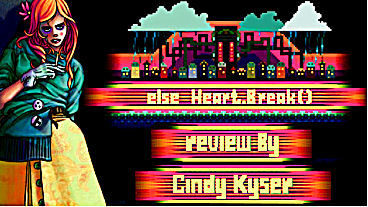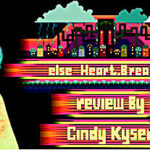
else Heart.Break() Review
It’s a step back into the classic age of adventuring, with an interesting twist







Genre: Adventure
Release date: September 24, 2015
Note: This review includes spoilers.
else Heart.Break() is the newest release from a group of independent Swedish developers that includes Erik Svedäng, Niklas Akerblad, Tobias Sjögren, Oscar Rydelius, and Johannes Gotlén. The team has previously collaborated on such games as Blueberry Garden, Clairvoyance, and Kometen. They describe else Heart.Break() as a “re-imagination of the adventure game.’” After playing the title, I would heartily agree. It’s a step back into the classic age of adventuring, with an interesting twist..
The game opens in a house with Sebastian and his family. The phone rings and Sebastian receives an unexpected job offer from Wellspring Soda. He accepts and travels by ship to the city of Dorisburg. Once there he’s instructed to check into his hotel and meet a co-worker for a sales briefing. As he disembarks, your adventure begins. I was immediately reminded of the original Gabriel Knight: Sins of the Fathers where, from an overhead view, you move your character through a game world and gather information to determine your next step. As in this adventure, your only option is to begin wandering the town, snooping around and talking with the people you encounter.
As I traversed Dorisburg it became apparent that this was a very different experience. There’s a multitude of doors to open and places to explore. The town is complex, with many areas including parks, businesses, residences, factories, and nightclubs. Each room has objects to examine, materials to read and computers to play with. The characters move about freely and dialog is rarely repeated. With Gabriel Knight I grew weary of trudging between locations and replaying conversations in hopes of getting one new piece of information. Not so with else Heart.Break(). Dorisburg is dynamic and alive, and there’s something new with each corner you turn.
If you’re smart, you’ll first visit the Dorisburg Information Center and pick up a map of the town. Although it doesn’t have a “you are here” function, it becomes invaluable when coupled with street signs. What first feels like a labyrinth becomes a familiar landscape in short order. For those who aren’t up for a walking tour of the city, a train can be ridden to specific points which are noted on the map.
A few challenges become immediately apparent. Inventory is limited. As in real life, only so many items will fit in your bag. Thus, the strategy of taking everything “just in case” isn’t an option. Second, sleep is essential. Not paying attention to how tired you are can result in dropping in your tracks and waking up 8 hours later! Luckily, your need to sleep can be partially mitigated by consuming large amounts of coffee that’s available everywhere. Lastly, there’s a game clock running, counting out days and hours. If you’re invited to a party at 8:00pm, you need to carefully plan your day and sleep schedule to avoid missing the event.
On my first attempt at else Heart.Break(), I spent several game days with only marginal success as a soda salesman. I had a bag full of stuff and nothing was making sense. I decided to start over, keeping in mind some suggestions made by the developers:
1. Wellspring Soda is merely your ticket to Dorisburg. You have a higher calling than soft drink sales and your objective is to discover it Since most items you need are free for the taking, earning money is not important.
2. Talk repeatedly with everyone you encounter. If a place is mentioned, go spend time there. If a person is named, go find them and cultivate a relationship.
With this new approach, the game became infinitely more interesting.
Like most classic adventure games, there’s a lot of dialog with multiple choices. There are no voice-overs. Instead conversation is presented in “bubbles” to be read like a comic strip. Although you have multiple options for conversation, it’s not clear that your choices are actually driving the story. Much of the dialog is fairly inane (“What’s up?” “I dunno…” ). Often, your response options are minimal (“Yes”, “Sure”, or “Uhhh…”). The trivial chit-chat can be clicked through quickly as you work to get characters to reveal information that you can really use.
Despite the absence of spoken dialog, the sounds of else Heart.Break() are rich. As you move through the game, the environment is filled with the sounds of the city, machinery, music, and footsteps. With a good set of headphones, you have the sense that you really are experiencing Dorisburg. Sit back, listen, and don’t be afraid to step onto a dance floor and move to some great music!
The graphics of else Heart.Break() are a study in contrast. The landscape is displayed in “chunks,” with only your current location visible. From a bird’s-eye view, you can zoom in and out and scan right and left with single keystrokes. You click on a spot and Sebastian moves there. You double click and he runs. There’s a transition moment when your path crosses a boundary into a new area. The graphics are detailed and in 3D which allows you to walk around objects and view all sides of a room or building. The characters are stylized with interesting faces and colorful clothing.
However, the menus and titles are presented in a low-resolution font that reminds me of life before the time PCs had a graphical user interface. The computers that you find throughout the game have the feel of a mainframe “dumb” terminal with command line functions. As you move deeper into the game and begin to understand the technology framework of Dorisburg, this low-tech feel begins to make sense.
There’s no way to review this game without a mild spoiler. Dorisburg is a town that’s been taken over by technology and is governed by a Computer Ministry. Everything is computer-driven… from your coffee, to your hotel key, to humidity sensors. Total automation provides the Ministry with tight control over all aspects of life in Dorisburg and a rebellion is in progress. Sebastian finds his way into an underground group and, in order to join them, must equip himself with the tools and knowledge to become a computer hacker. And this is where else Heart.Break() becomes so fascinating.
Once you know what you’re doing, the game is filled with opportunities to hack. You open an object, view the source code, rewrite it, compile it, and things change. Your coffee can be hacked to triple strength; you can become a system administrator; your hotel key can be hacked to open other doors; passwords can be changed and computers can be given new instructions. Ultimately, you can hack your way into traversing the internet itself, which is presented as a virtual world of colorful pathways between computers.
Back in the day I programmed in a variety of languages. Thus, the concepts of variables, functions, and code structure are second nature to me. Once I realized what I could do in else Heart.Break() I was hooked. It’s a very long and complicated game, with side quests and many opportunities for creative play. Instead of tiring of Dorisburg, I kept coming back with a new idea or a different approach. The developers were kind enough to provide an explicit save function as well as an auto-save. Thus, when I realized that Sebastian had slept through something important, I restored to a prior save point and planned his day differently. In short, I was fully engaged throughout else Heart.Break() and it’s likely that I’ll replay it just to see what I missed the first time through.
I should stress that a degree in computer science is not needed to enjoy else Heart.Break(). It simply requires a willingness to stretch your mind, learn new tricks and be persistent as you build your hacking skills by talking with experts and reading instructions. Who knows… perhaps the magic of writing code snippets will capture your imagination and you’ll decide on becoming a game developer.
On the other hand, if you’re looking for pure entertainment without exercising some serious linear thinking, then this game may not be for you.
In my mind, a ‘great’ adventure should have a complex story line, characters that I care about, a quest, and a reward at the end. else Heart.Break() doesn’t meet these criteria on a number of levels. The story isn’t particularly compelling and the characters are shallow and often silly. The quest is solid (that is, going up against an evil bureaucracy to rescue a friend) but, in the end, Sebastian retreats to safety rather than rising in victory.
However, at the end the day none of this matters. The development team did a beautiful job of integrating hacking into the core of this game and, as a result, created a wonderful and unique departure from traditional adventuring. The game is unlike anything I’ve played before. I enjoyed the game so much that I quit worrying about story and characters and just settled in for the pure fun of it.
|
+ Hacking provides a serious intellectual challenge for those who are inclined to stretch.
+ Explicit Save provides flexibility for the player
+ Navigation is simple and uses only the mouse and a few keys
– Long and complicated adventure – do not expect to finish this in a few days
– Requires careful attention to dialog, and note-taking is advised for those with less than perfect memory
– Writing code snippets may not be some adventurer’s idea of entertainment |

|
Processor: Core 2.4 Duo GHz
Memory: 2 GB RAM
Graphics: Dedicated graphics card
Hard Drive: 1.5 GB available space
Processor: Core 2 Duo 2.4 GHz
Memory: 2 GB RAM
Graphics: Dedicated graphics card

Leave a Reply